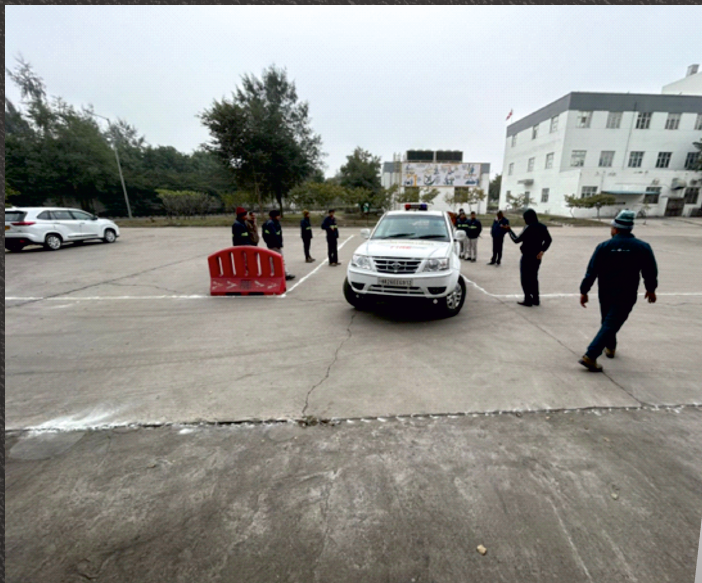SECURING ROAD SAFETY FOR ALL: AN ESSENTIAL ECUMENICAL MANDATE
TABLE OF CONTENTS:
- Current State of road security
- Factors Affecting Traffic Security
- International Road Safety Policies & Protocols
- Exemplary Approaches and Prosperity Stories
- What lies ahead?
Ensuring road safety for everyone is a crucial issue that affects people all over the world. Millions of individuals rely on road conveyance for sundry purposes, including commuting, peregrinating, and conveying goods. However, due to the increasing number of conveyances and inadequate infrastructure, Vehicle safety has become an ecumenical concern.
Promote safer roads, both individuals and governments must take certain steps. Firstly, drivers must adhere to traffic regulations. Another way to enhance road safety is by maintaining vehicles in good condition. Poorly maintained vehicles can lead to accidents on the road. Regular maintenance checks are vital to ensure that vehicles are in optimal working order. Drivers should also confirm that their vehicles are roadworthy before starting any journey.

Current State of Road Security
The current state of road security is alarming, despite the efforts made by regimes and organizations. Road accidents perpetuate to claim numerous lives and cause astringent injuries ecumenical. According to the World Health Organization (WHO), road accidents are responsible for approximately 1.35 million deaths each year, making it a leading cause of death ecumenically, categorically among adolescent adults aged 15-29. Furthermore, road accidents result in consequential economic losses, encumbering healthcare systems and impacting national economies.
Factors Affecting Traffic Security
Several factors contribute to the alarming state of traffic security ecumenical. One crucial factor is the exponential magnification in the number of conveyances. As countries experience economic development, more individuals can afford cars and motorcycles, leading to congested roadways. Inadequate infrastructure development, including poorly designed roads, deficient signage, and a lack of pedestrian-convivial facilities, further exacerbate the quandary. Moreover, temerarious driving deportments such as speeding, inebriated driving, diverted driving, and failure to utilize seat belts or helmets significantly contribute to road accidents. Supplementally, regions with inadequate driver edification and licensing systems face incremented risks on the road. Addressing these factors necessitates collaborative efforts from regimes, organizations, and individuals.
International Road Safety Policies & Protocols
The exigent desideratum for a coalesced ecumenical replication to amend transportation security has led to the launch of the Decennium of Action for Safer paths 2011-2020 by the Cumulated Nations. This initiative aims to address the alarming number of road traffic fatalities ecumenical through collaborative efforts. The focus is on five key pillars: safe passage management, safer roads and mobility, safer conveyances, safer road users, and amended post-crash replication. By collaborating, we can invigorate rules and legislation, enhance road design, promote the utilization of seat belts and helmets, and edify the public about responsible driving. It is through collective action that we can make paramount progress in ascertaining safer roads for all.
Exemplary Approaches and Prosperity Stories
Sundry countries have prosperously implemented safe streets measures that can accommodate as exemplary approaches for others. Sweden, for example, has adopted the Vision Zero approach, aiming to eliminate all road deaths and earnest injuries. This comprehensive strategy prioritizes safer road design, lower speed limits, and incremented law enforcement. As a result, Sweden has witnessed a consequential abbreviation in road fatalities. Similarly, Australia has made remarkable progress by implementing comprehensive road awareness programs like the “Towards Zero” initiative. This multifaceted strategy cumulates engineering, inculcation, and enforcement measures to engender a safer road environment. Australia’s prosperity story accentuates the consequentiality of a collaborative approach to safer transport methods, highlighting the positive outcomes that can be achieved through collective efforts.
What lies ahead?
Crosswalk safety is a critical ecumenical concern that demands immediate attention and collective efforts. Regimes, organizations, and individuals must converge to address the underlying factors contributing to road accidents and implement efficacious measures. By amending road infrastructure, promoting responsible driving demeanours, and enhancing post-crash replication, paramount strides can be made towards achieving safer roads ecumenical. As responsible individuals, we can contribute to this cause by rigorously adhering to traffic rules, evading diversions, and prioritizing our own safety. Everyone’s commitment to responsible driving plays a crucial role in engendering a safer road environment for everyone.
Here are answers to frequently asked questions on road safety scenarios across the globe:
Analyse and describe the current state of road security?
According to official statistics published by the Ministry of Road Transport and Highways (MoRTH), 153,972 persons were killed in road crashes in the year 2021. This corresponds to 11.3 deaths per 100,000 population. Of those who died, only 14% are females and the rest are males. Over the last decade (2009-2019) road traffic crashes have been 13th largest contributor to health burden (deaths and disabilities) in India. For the working age population (15-49 years), they are the sixth largest contributor.
What are the Factors Affecting creation of safe passages?
Traffic accidents are the results of several factors including the roadway geometric design elements, the type and condition of the pavement surface conditions, the prevailing environmental factors, roadway lighting, the urban–rural designation of the segment, the vehicle conditions, traffic flow characteristics and the compositions (percentage of trucks), the vehicle condition, and the human factors.
Highlight the International Road Safety policies?
Between 2000 and 2014, the World Health Organization established the Department of Injuries and Violence Prevention, developed a five-year strategy for road traffic injury prevention, and published a Global Status Report on transportation safety. The Moscow Declaration called for a Decade of Action from 2011-2020. In 2021, governments declared the consecutive Second Decade of Action, aiming to reduce road accident deaths and injuries by at least 50%. The UN’s Global Plan for Decade of Action for Road Safety was officially launched on 28 October 2021.
Highlight the Exemplary Approaches and Prosperity Stories of crosswalk safety?
- Belgaum Yaragatti Highway’s Safe Corridor Demonstration Project (SCDP), Karnataka – recorded a 54% reduction in deaths from 2015 to 2018.
- Kazhakoottam-Adoor (SH-1) Safe Corridor Demonstration Project (SCDP), Kerala – recorded a 46% reduction in deaths from 2013 to 2021.
- Renigunta-Kadapa Stretch (SH-31), Andhra Pradesh (Case Study 5) – recorded a 22% reduction in deaths from 2012 to 2015.
- Bharuch-Dehgam Corridor, Gandhinagar-Koba-Indira Bridge, Mehsana Himatnagar Highway, Gujarat – resulted in improved safety standards.
- Uthiramerur – Kannamangalam Corridor (SH 118A) Tamil Nadu Road Sector Project II, Tamil Nadu – resulted in improved safety standards.
In a world where road safety affects millions, it’s imperative to understand the current challenges, international policies, and exemplary approaches towards creating safer roadways. Let’s delve into the FAQs that shed light on the pressing issues and potential solutions, all underlining the essential ecumenical mandate of securing road safety for all.









Road safety is essential for protecting lives, enhancing economic productivity, and improving the overall quality of life. By prioritizing road safety, societies can ensure safer travel environments, reduce the burden on healthcare systems, and support sustainable development goals. It is very well written on the burning issue of road safety.